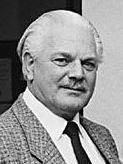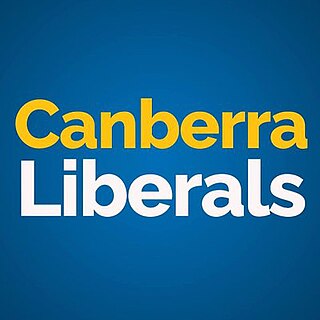Related Research Articles
The premiers and chief ministers of the Australian states and territories are the heads of the executive governments in the six states and two self-governing territories of Australia. They perform the same function at the state and territory level as the Prime Minister of Australia performs at the national level. The King of Australia and the state governors are the formal repositories of executive power; however, in practice they act only on the advice of state premiers and ministers except in extreme circumstances, such as a constitutional crisis.

Rosemary Follett is an Australian former politician who was the first Chief Minister of Australian Capital Territory, serving in 1989 and again between 1991 and 1995. She was the first woman to become head of government in an Australian state or territory.

The Sun Ripened Warm Tomato Party was an Australian joke political party that contested the first election for the Australian Capital Territory Legislative Assembly in 1989.
The Independents Group was a short-lived Australian political party operating in the Australian Capital Territory. They briefly served as part of the Alliance government, alongside the Liberal Party and Residents Rally.

Trevor Thomas Kaine, was an Australian politician who served as Chief Minister of the Australian Capital Territory from 1989 to 1991. Kaine was elected into a multi-member single electorate in the unicameral Australian Capital Territory Legislative Assembly, from 1989 to 2001, initially as a member of the Liberal Party and later as an independent.

The 1989 Australian Capital Territory general election was held on 4 March 1989 to elect the 1st Australian Capital Territory Legislative Assembly. This was the first direct election by voters in the Australian Capital Territory (ACT) for their power legislative body.

Elections to the 1992 Australian Capital Territory Legislative Assembly was held on Saturday, 15 February, alongside a referendum on an electoral system for future elections. The incumbent Labor Party, led by Rosemary Follett, was challenged by the Liberal Party, led by Trevor Kaine. Candidates were elected to fill seats using the modified d'Hondt electoral system for a multi-member single constituency. The result was another hung parliament. However, Labor, with the largest representation in the 17-member unicameral Assembly, formed Government with the support of Michael Moore and Helen Szuty. Follett was elected Chief Minister at the first sitting of the second Assembly on 27 March 1992.
The Australian Capital Territory House of Assembly was the main elected representative body of the Australian Capital Territory between 1975 and 1986, during which time preparation began for the granting of self-government to the Territory. The Assembly had a largely advisory role, with most of the power over the Territory being in the hands of the relevant federal minister.
Michael John Moore is an Australian public health leader, academic and former politician. He was an independent member of the Australian Capital Territory Legislative Assembly for four terms, from 1989 to 2001. He served as Australia's first independent minister as Minister for Health and Community Care from 1998 to 2001 in the Liberal minority government led by Chief Minister, Kate Carnell and later, Gary Humphries.

Bernard Joseph Edward Collaery is an Australian barrister, lawyer and former politician. Collaery was a member of the Australian Capital Territory's first Legislative Assembly for the Residents Rally party, from 1989 to 1992. He served as Deputy Chief Minister and Attorney-General from 1989 to 1991 in the Kaine Alliance Government.
Paul Russell Whalan is an Australian political lobbyist and former politician who was a member of the first Australian Capital Territory Legislative Assembly. He served as the leader of the ACT Labor Party in the mid-1980s and was the leader of the party's Right faction.
The First Follett Ministry was the first ministry of the Government of the Australian Capital Territory, and was led by Labor Chief Minister Rosemary Follett and her deputy, Paul Whalan. It was sworn in on 16 May 1989, after the 1989 election when a hung parliament was the outcome. Labor, with a plurality of seats, led a minority government in the Australian Capital Territory Legislative Assembly.
The Kaine Ministry was the second ministry of the Government of the Australian Capital Territory, and was a coalition led by Liberal Chief Minister Trevor Kaine and his deputy, Residents Rally party leader Bernard Collaery. It was sworn in on 5 December 1989, when Collaery moved the following motion:

The Deputy Chief Minister of the Australian Capital Territory is the second-most senior officer in the government of the Australian Capital Territory. The position has been a ministerial portfolio since its establishment in 1989. Unlike in other states and territories, the deputy chief minister of the ACT is not nominally appointed by an administrator or vice-regal, but by the chief minister.
The ACT Labor Party, officially known as the Australian Labor Party (ACT Branch) and commonly referred to simply as ACT Labor, is the Australian Capital Territory branch of the Australian Labor Party (ALP). The branch is the current ruling party in the ACT and is led by Andrew Barr, who has concurrently served as chief minister since 2014. It is one of two major parties in the unicameral ACT Legislative Assembly, and is currently in a coalition with the ACT Greens.

The Canberra Liberals, officially known as the Liberal Party of Australia, is the division of the Liberal Party of Australia in the Australian Capital Territory (ACT). The party has been in opposition in the ACT Legislative Assembly for much of its existence, but held power with the support of minor parties and independents between 1989 and 1991 and again between 1995 and 2001. It is currently the only state or territory division of either major party to be unrepresented in the Federal Parliament.

The 2024 Australian Capital Territory general election was held on 19 October 2024 to elect all 25 members of the unicameral ACT Legislative Assembly.
The Labor–Greens coalition was a political alliance between the Labor Party and the Greens in the Australian Capital Territory Legislative Assembly. The coalition was founded in 2012 but was dissolved after the 2024 election, with the Greens moving to the crossbench.
The ACT Labor Party, the division of the Australian Labor Party in the Australian Capital Territory (ACT), have held a number of leadership elections and deputy leadership elections. The most recent was held in November 2020, although the most recent leadership change was in December 2014.

The Alliance, sometimes known as the Liberal–Residents Rally Alliance, was a political alliance between the Liberal Party, Residents Rally and Independents Group in the Australian Capital Territory Legislative Assembly.
References
- ↑ "Canberra groups to rally against city planning". The Canberra Times. 29 October 1987. p. 3. Retrieved 31 October 2024.
- ↑ "Residents Rally to register as a political party". The Canberra Times. 2 May 1988. p. 3. Retrieved 31 October 2024.
- ↑ "CITY HILL: Review of the Draft Master Plan" (PDF). AustLII. June 1993. Retrieved 31 October 2024.
- ↑ "CANBERRA'S PLANNING AND DEVELOPMENT". Lake Burley Griffin Guardians. 21 September 2020. Retrieved 31 October 2024.
- ↑ Moore, Michael (27 February 2019). "The government we didn't want is here to stay". Canberra CityNews. Archived from the original on 20 March 2019. Retrieved 24 October 2024.
- ↑ Collaery, Bernard. "Community Policing - an ACT Perspective". Australian Institute of Criminology. Retrieved 30 September 2009.
- ↑ Mason, Leanne (25 June 1991). "Collaery to form party to strike at top job". The Canberra Times. p. 1. Retrieved 31 October 2024.
- ↑ Coelli, Andree (6 December 1989). "Alliance takes the reins". The Canberra Times. p. 1. Retrieved 23 October 2024.
- ↑ Mason, Leanne (7 June 1991). "Follett retakes Govt". The Canberra Times. p. 1. Retrieved 21 October 2024.
- ↑ Grose, Simon (21 February 1995). "Much ado about building". The Canberra Times. p. 10. Retrieved 31 October 2024.
- ↑ "Canberra groups to rally against city planning". The Canberra Times . Vol. 62, no. 19, 017. Australian Capital Territory, Australia. 29 October 1987. p. 3. Retrieved 19 April 2021– via National Library of Australia.